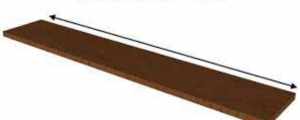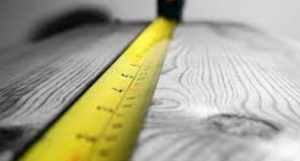Let’s say you’re moving from a three-bedroom home, and you get a quote for nineteen feet in a trailer. But you’re not exactly sure how much space you need. No problem. Your section includes a per-foot rate that you can add or subtract to calculate your final price. If you’re a super packer and only end up using 17 feet, that’s all you pay for; subtract the per-foot rate for each foot you don’t use. So, what is linear feet?
However, if you fill up 21 feet, add the per-foot rate for each extra foot you use. Charging by the linear foot is what makes your pack so flexible. No worries. In this article, we’ll discuss on your query and how it works and all. Without further ado, let’s start.
Table of Contents
What is linear feet?
There are a bunch of measurement styles. These are followed in different construction activities. It helps to calculate and determine the number of specific materials you need for the activity. However, to calculate other measurements, Linear Foot is one of the most commonly used methods. It is a twelve inches straight line simply.

Besides, it is also often called linear feet. There is no difference between regular feet and linear feet. For instance, if we call a wall six linear feet high, it is nothing but a six-foot-high fence. In general, you can measure a straight distance from point X to point Y. As we know, linear means straight, and a foot is nothing but 12 inches long. This is how we can understand the measurement of linear feet.
How to calculate linear feet?
So, now you know what linear foot is, right? It’s twelve inches. Like a regular foot in length, it includes the entire width and height of the trailer. Outside trailer dimensions are 28 feet long, 8 feet wide and 9 feet tall. Think a bit like a loaf of bread with 28 slices. Each slice is one linear foot. How many pieces you use depends on how much you’re moving and how well you pack and load. Anyways, how do you calculate linear feet?
Let’s say you measure a dining table. To begin with, you need to measure height, length, and weight. Suppose it is 5ft, 7ft and 9ft in order. Now, sum this up, and you’ll get your linear foot. You’ll get 5+7+9=31 ft.
This is the general method. Apart from that, there are other methods as well. For instance,
- Deck Project calculation
- Bookshelf Project calculation
- Using Specialized Calculators
Depending on the use and situation, these methods come into play.
What is linear feet vs. feet?
Actually, both the feet and linear feet is the same but different thing. With feet, we can measure height, weight and length. Even the volume and area also. In contrast, linear foot denote only one precise measurement at a time. When we objectify one measurement in feet, we use linear foot. On the other hand, feet indicate a vast portion, including square feet, cubic feet and many more.
To make it clearer, let’s give you an example; if we say the rope is 10 feet long, we meant 10 linear feet is the length. At the same time, it means 10 regular feet also. So they both are the same. However, if we say the table area is 12 square feet, we say feet instead of linear feet. In brief, it comes when there is a straight line, like points X to Y. I hope it makes sense.

Now, if you ask, “can we convert feet to linear feet?” Unfortunately, it is not possible. Why? Because you can not convert an area to a single line. However, you can do some additional measurements if needed. For that, you need to know the line value of the area.
What is linear feet vs. square feet?
Indeed, there are some fundamental differences between linear feet and square feet. It is a matter of the fact that square feet generally refer to the measurement of area. On the other hand, linear foot indicates the length. Therefore, this is undoubtedly the fundamental difference between them.
With some practical examples, you can get it more easily. Like prices of various flooring products are measured in square feet. But products like carpets are sold in linear foot. In order to get the necessary measurement, you can apply this mathematical difference quite quickly.
How do I convert feet to linear feet?
Generally, when we refer to 12 inches, we mean feet. At the same time, it is linear foot as well. To convert feet to linear feet, we need to follow specific steps. At first, take the length of the particular object. In linear foot, the width or height is not calculated. Make sure the surface is plain and straight. Now, calculate the length in inches and record it on paper. Finally, divide the total number (in inches) by 12 to measure the linear feet. As simple as that.
Simple conversion table of feet to linear feet:
| Feet | Linear feet |
| 1 | 1 |
| 2 | 2 |
| 3 | 3 |
| 4 | 4 |
| 5 | 5 |
| 6 | 6 |
| 7 | 7 |
| 8 | 8 |
| 9 | 9 |
| 10 | 10 |
What is the difference between linear feet and regular feet?
Every measurement has its unique mathematical methods. However, linear foot measurement is one of the simplest calculations. Let’s talk about an example to simplify the difference. For instance, in freight shipping, you are dealing with volume. As we know, volume is associated with three-dimensional space; it refers to cubic feet rather than considering any other measurement method.
What is a linear foot fence?
Suppose you have a 5 feet wide and 20 ft long fence. Now, you want to know the linear feet of the wall. As the mathematical rule suggests, measuring the foot fence, we tend to overlook the width. Therefore, the linear foot fence will be 20 ft.
However, there are times we are making fences, i.e., wood fence or aluminum fence or others, then don’t forget to subtract the overlapping area. What we need to do is subtract the overlapping board area. After that, divide the result using the length of the fence. We are halfway done. Now, count the number of slats and multiply them with the fence height. Eventually, you’ll get the linear foot for the materials.
How to calculate linear feet of a wall
In order to calculate the linear foot of a wall, we need few things:
- Tape
- Calculator
- Paper and pen
Once we arranged the materials we need, we are good to go. Firstly, using the tape, measure the length of the wall from one end to another. Besides, you need to record them in pen and paper. The measurement should be in inches.
Secondly, using the same tape, measure the surface of the wall. Please don’t skip any part, whether a corner or a protruding or recessed notch or bend or edge; simply count everything on the surface.
Finally, take the calculator and add all the measurements you recorder on the paper. Then divide that by 12 so that you can convert it into feet. Undoubtedly, the total sum will be the linear feet of the wall—easy pissy.
FAQs
1: Is a linear foot 12 inches?
Answer: We all know 12 inches is equals 1 foot. Hence, a linear foot is defined as precisely as it is. This is no more or less than 12 inches in length.
2: How many square feet is a 20×20 room?
Answer: Apparently, the length is 20, and the width is also the same. Hence, in order to calculate square feet, simply multiply length x width. So, the result comes 400.
3: What is the perimeter of 10×10 room in linear foot?
Answer: Firstly, we need to divide 80 by 8, and we’ll get 10 as a result. This is the width of the room in linear foot. Now, our main goal is to calculate the perimeter. Hence, we’ll add two of the length and two widths in an order. Let’s see, the perimeter of a 10×10 room in linear feet is (8 x 2) + (10 x 2) = 36 linear feet.
Final thoughts
To conclude, we cover most of the things related to what is linear feet. Hopefully, this article helped you with the answers you were looking for. The calculations are a bit difficult if you hate mathematics. However, these are all basic calculations, no scientific ones. Still, we tried to explain in simple terms.
If you found this helpful article, share it with your friends and family. Let us know if there is any question you are having in the comment box. We’ll get back to you as soon as possible. Have a nice day!








